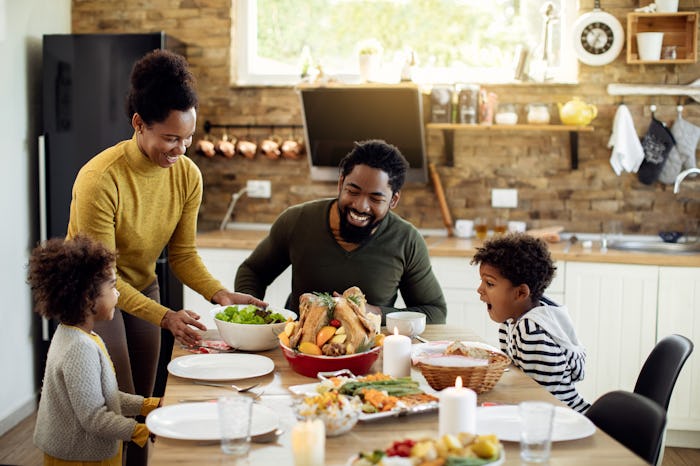Thanksgiving

How To Explain The True History Of Thanksgiving To Your Kids
Because it’s not as simple as history books make it seem.
I was a few feet away from my daughter when she stood up in her kindergarten class to give her Thanksgiving speech. She had the traditionally crafted paper headband with colored feathers and her name written on the inside. I smiled with pride at her confidence and articulation while she spoke, but part of me held a breath wondering, When will I tell her the truth?
Thanksgiving is one of the biggest smoke screened holidays next to Christopher Columbus Day, where the truth gets twisted until it’s broken and transformed into an easy to digest version of what really happened between pilgrims and Native Americans. It wasn’t rainbows and sunshine.
The holiday has become a gathering with loved ones over an amazing meal, while expressing gratitude for all that you have. Which is a great time of reflection and appreciation. But at some point we have to stop glossing over the true cultural roots of the day.
Revealing the un-doctored history of Thanksgiving involves shedding some commercialized hooplah, and even some of what is taught in schools. In order to keep the spirit of the holiday alive without furthering the lies, here are a few tips on explaining the real history of Thanksgiving to your kids.
Begin With Questions About Thanksgiving
Ask your child what they think Thanksgiving is all about, including what they’ve learned from school. This gives you a bead on how many layers you may need to wade through and where to start.
Break Down Traditions & Highlights Of Thanksgiving
- In 1620 after the Mayflower Pilgrims arrived at Plymouth Harbor, they encountered an English speaking Native American named Squanto. He is historically known as the “Patuxet Native who saved the pilgrims of the Mayflower” because he taught them how to survive.
- Plymouth colonists who made it through the winter alive had a feast with the Wampanoag Indian tribe.
- They ate deer — not turkey — and the Wampanoag were generally pretty accepting of the pilgrims who dined with them.
- What people then believed to be Thanksgiving actually took place over three nights.
- It was many, many years later in the 1860s that President Abraham Lincoln decided to declare Thanksgiving, as the world knows it, a national holiday. But, it was Lincoln who also decided to tell this "peaceful version" of the story to others during the Civil War.
- Lincoln made his Thanksgiving proclamation because of journalist Sarah Josepha Hale, who campaigned many years for it to become a national holiday. She wrote Lincoln a letter saying this would be a “great Union Festival of America.”
Be Honest About The Ugly Events Behind Thanksgiving
There are many ugly moments that occurred during and after this time that you shouldn't gloss over.
- The colonists started claiming land that wasn't really theirs to begin with, and many of the original land dwellers were kept as slaves.
- The term "Thanksgiving" was once credited to John Winthrop after the slaying of 700 Pequot Indians by colonists.
- Even during that Wampanoag venison feast, the new settlers were aggressive and saw the Indians as savages, despite their willingness to help and protect.
The basis of Thanksgiving as we know it today is centered around gratitude. But for the early settlers, greed was their driving force. They would not have survived without the resources and skills taught by the Native Americans. However, instead of trying to live peacefully with the people who’d kept them alive, colonizers stole their lands, enslaved and murdered them.
Use Resources
Any resources you can pull from to break down this information in a comprehensive and fun way for your children will help this information stick and keep their attention.
Try this short video that explains Thanksgiving to kids. You will still have to fill in some of the grisly parts, but it explains how the Native Americans helped the new settlers and how the settlers likely wouldn't have made it far without that bit of gratitude.
You can also shift the attention from the settlers to the Tribes that were impacted using fun literature like the book The Children of the Morning Light: Wampanoag Tales as Told By Manitonquat or Tapenum's Day: A Wampanoag Indian Boy In Pilgrim.
Discussing the history of Thanksgiving with your family present makes it more interactive. And you can collectively show respect for true historical events. Now your children can come into this holiday gathering with a clear understanding of how Thanksgiving began, honoring the kindness shown by the Native Americans, and sincere gratitude for what they have in their lives. An attribute that should have been in the hearts of the pilgrims, but wasn’t. All together, your family will help educate your child about why some of the actions of the colonists were inappropriate, and how we, as people, vow to never make the same mistakes again.
Although the roots of this holiday are definitely sad, educating your child, and morphing the day into a positive one that includes a lot of gratitude definitely helps.
This article was originally published on